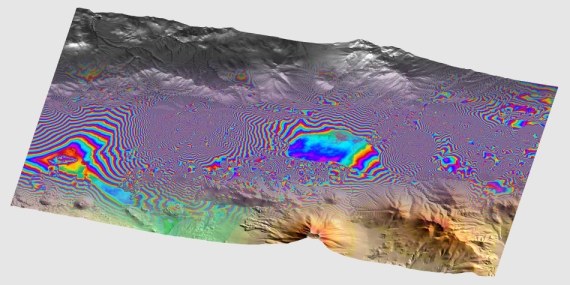SAR
SAR processors are designed as so-called end-to-end systems which generate highly precise calibrated products for scientists and commercial users from the bit data stream coming from SAR instruments.

As an example, the figure depicts the essential steps of the interferometric processing procedure as developed for the TanDEM-X mission. By focusing the holographically recorded radar echo, a sharp image can be obtained of the radar reflectivity of the earth’s surface. In addition to signal strength, shown as grey values in the upper left part of the figure, these images also contain very precise distance information in the form of phase angles. From the difference in phases between two SAR images which have been recorded from slightly different perspectives an interferogram is produced, shown in the central part of the figure as a pattern of colored stripes. After resolving phase ambiguities and knowing the exact recording geometry, it can be used to generate a digital elevation model of the earth’s surface, as indicated in the lower right colored portion of the figure.
Development phases of a SAR processor
The development of an operational SAR processor normally requires several years and includes the following steps:
- Defining system specifications derived from user requirements, taking into account the instrument parameters and the orbit characteristics
- Generating realistic test data with the help of simulation tools, especially for innovative receiving modes like Spotlight or TOPS
- Designing modular and robust software
- Efficiently coding the software on parallel computers
- Further developing the software, and version management during the satellite’s 5-10 year operational phase.
The most important developments are the TerraSAR Multi-Mode SAR Processor TMSP and the Integrated TanDEM-X Processor ITP.
TerraSAR Multi-Mode SAR Processor (TMSP)
This tool processes all SAR data from the TerraSAR-X mission. It is used in the DLR ground segment as well as in the receiving stations of external partners worldwide. The special characteristics of the system are:
- Highly optimized multimode capability and an accurately phasing focusing algorithm for processing data recorded in the SAR Staring and Sliding Spotlight, Stripmap, ScanSAR and WideScanSAR receiving modes
- Calculation of processing parameters and correction functions for the antenna illumination with the help of a terrain model
- Optional subtraction of thermal noise for all reception modes
- Processing the experimental aperture-switching and along-track interferometry modes
- Availability of the system for different hardware architectures and operating systems.
Based on TMSP developments, also an end-to-end SAR processor was created for routine operations within the ground segment of the Spanish PAZ mission.
Integrated TanDEM-X Processor (ITP)
The first configuration of two SAR satellites and the bistatic interferometric recording principle of the TanDEM-X mission pose new challenges for SAR data processing. The ITP processing systems combines the aspects of bistatic SAR processing, interferometric processing, and, finally, the generation of digital elevation models from the derived phase information. The special characteristics of the system are:
- Analysis of differential deviations of the oscillators of both satellites and compensation for the temporal and phase drifts in the SAR signals which they cause
- Highly precise, centimeter-scale co-registration of both SAR images
- Innovative and robust methodologies for resolving phase ambiguities (“phase unwrapping”)
- Efficient calculation and geocoding of the elevation data contained in the interferometric phases.
Besides developing end-to-end processors, anticipating future missions the team is designing innovative algorithmic processing concepts for new SAR instrument technologies like frequency-scan methodologies for azimuthally-distributed phase centres at the receiving antennas. These concepts are key elements of a proposed High-Resolution Wide-Swath (HRWS) mission to follow TerraSAR-X. For other future SAR missions, for example those specifying on-board processing of SAR data, the team is currently implementing a hardware-dependent SAR focusing algorithm in a FPGA component as part of a Horizon 2020 European funding project. On the other hand, for future on-ground processing the team will also include GPGPUs.
